Harmonic Order Analysis of Cogging Torque for Interior Permanent Magnet Synchronous Motor Considering Manufacturing Disturbances
Abstract
:1. Introduction
2. Analysis Model and Measurement
2.1. Analysis Model
2.2. Measurement
3. Harmonic Order Analysis of Cogging Torque
3.1. Manufacturing Disturbances
- Dimension: Eccentricity on external diameter of rotor, and slot opening of stator;
- Assembly: skew angle.
- Magnetization of permanent magnet
3.2. Magnetization Disturbances
3.3. Disturbances for the Dimension and Assembly
3.4. Harmonic Order Analysis
3.5. Analysis Results
4. Conclusions
Author Contributions
Funding
Institutional Review Board Statement
Informed Consent Statement
Data Availability Statement
Conflicts of Interest
References
- Bebregergis, A.; Chowdhury, M.H.; Islam, M.S.; Sebastian, T. Modeling of permanent-magnet synchronous machine including torque ripple effects. IEEE Trans. Ind. Appl. 2015, 51, 232–239. [Google Scholar] [CrossRef]
- Yang, H.; Ademin, S.; Mcmahon, R.-A. Comparative study on multiple three-phase permanent magnet motors in fault tolerance electric power steering application. In Proceedings of the 10th International Conference on Power Electronics, Machines and Drives (PEMD 2020), Online Conference, 15–17 December 2020; p. 15022020. [Google Scholar]
- Islam, M.S.; Mikail, R.; Kabir, M.A.; Husain, I. Torque Ripple and Radial Force Minimization of Fractional Slot Permanent Magnet Machines Through Stator Harmonic Elimination. IEEE Trans. Electr. 2022, 8, 1072–1084. [Google Scholar] [CrossRef]
- Wu, L.-J.; Zhu, Z.-Q.; Staton, D.-A.; Popescu, M.; Hawkins, D. Comparison of analytical models of cogging torque in surface-mounted PM machines. IEEE Trans. Ind. Electr. 2012, 59, 2414–2425. [Google Scholar] [CrossRef]
- Lee, C.-S.; Jung, G.-T.; Hong, J.-P.; Kim, H.-J.; Kim, Y.-K. Design of brushless permanent machine with skewed stator for electrical power steering system. J. Korean Mag. 2015, 25, 189–197. [Google Scholar] [CrossRef]
- Jiang, J.-W.; Bilgin, B.; Yang, Y.; Sathyan, A.; Dakhad, H.; Emadi, A. Rotor skew pattern design and optimization for cogging torque reduction. IET Electr. Syst. Trans. 2015, 6, 126–135. [Google Scholar] [CrossRef]
- Chen, W.; MA, J.; Wu, G.; Fang, Y. Torque ripple reduction of a salient-pole permanent magnet synchronous machine with an advanced step-skewed rotor design. IEEE Access 2020, 8, 118989–118999. [Google Scholar] [CrossRef]
- Wang, S.; Niu, S.; Zhao, X.; Fu, W. Novel dc-saturation-relieving hybrid reluctance machine with skewed permanent magnets for electric vehicle propulsion. IEEE Trans. Mag. 2022, 58, 1–5. [Google Scholar] [CrossRef]
- Islam, M.S.; Mir, S.; Sebastian, T. Issues in reducing the cogging torque of mass-produces permanent magnet brushless DC motor. IEEE Trans. Ind. Appl. 2004, 40, 813–820. [Google Scholar] [CrossRef]
- Hendershot, J.-R.; Miller, T.J.-E. Design of Brushless Permanent-Magnet Machines, 2nd ed.; Motor Design Books LLC: Venice, FL, USA, 2013; pp. 229–232. [Google Scholar]
- Wu, L.-J.; Zhu, Z.-Q.; Staton, D.; Popescu, D.; Hawkins, D. Analytical cogging torque prediction for surface-mounted PM machines accounting for different slot sizes and uneven positions. In Proceedings of the 2011 IEEE International Electric Machines & Drives Conference (IEMDC), Niagara Falls, ON, Canada, 15–18 May 2011; p. 15032021. [Google Scholar]
- García-Gracia, M.; Romero, A.-J.; Ciudad, J.-H. Cogging torque reduction based on a new pre-slot technique for a small wind generator. Energies 2018, 11, 3219. [Google Scholar] [CrossRef] [Green Version]
- Islam, R.; Husain, I.; Fardoun, A.; Mclaughlin, K. Permanent-magnet synchronous motor magnet designs with skewing for torque ripple and cogging torque reduction. IEEE Trans. Ind. Appl. 2009, 45, 152–160. [Google Scholar] [CrossRef]
- Zhou, Y.; Li, H.; Zhou, S.; Cao, Q. Analytical calculation of magnetic field and cogging torque in surface-mounted permanent-magnet machine accounting for any eccentric rotor shape. IEEE Trans. Ind. Appl. 2015, 62, 3438–3447. [Google Scholar] [CrossRef]
- Wang, K.; Zhu, Z.-Q.; Ombach, G.; Chlebosz, W. Average torque improvement of interior permanent-magnet machine using third harmonic in rotor shape. IEEE Trans. Ind. Electron. 2014, 9, 5047–5057. [Google Scholar] [CrossRef]
- Park, H.-J.; Lim, M.-S.; Lee, C.-S. Magnet shape design and verification for SPMSM of EPS system using cycloid curve. IEEE Access. 2019, 7, 137207–137216. [Google Scholar] [CrossRef]
- Lee, C.-S.; Cha, K.-S.; Park, J.-S.; Lim, M.-S. Tolerance-insensitive design of the magnet shape for a surface permanent magnet synchronous motor. Energies 2020, 13, 1311. [Google Scholar] [CrossRef] [Green Version]
- Yoneda, A.; Miyoshi, T.; Shimizu, Y. Cogging torque target and design of motor for EPS. In Proceedings of the SAE World Congress & Exhibition, Detroit, MI, USA, 3–6 April 2006; p. 13012006. [Google Scholar]
- Ganesan, S.; David, P.-W.; Balachandran, P.-K.; Samithas, D. Intelligent starting current-based fault identification of an induction motor operating under various power quality issues. Energies 2021, 14, 304. [Google Scholar] [CrossRef]
- Lee, S.-G.; Kim, S.-G.; Park, J.-C.; Lee, T.-H.; Lim, M.-S. Robust design optimization of SPMSM for robotic actuator considering assembly imperfection of segmented stator core. IEEE Trans. Energy Convers. 2020, 35, 2076–2085. [Google Scholar] [CrossRef]
- Kim, K.-S.; Jung, K.-T.; Kim, J.-M.; Hong, J.-P.; Kim, S.-I. Taguchi robust optimum design for reducing the cogging torque of EPS motors considering magnetic unbalance caused by manufacturing of tolerances of PM. IET Electr. Power Appl. 2016, 10, 909–915. [Google Scholar] [CrossRef]
- Guo, H.; Wu, Z.; Qian, H.; Yu, K.; Xu, J. Statistical analysis on the additional torque ripple caused by magnet tolerances in surface-mounted permanent magnet synchronous motors. IET Electr. Power Appl. 2015, 9, 183–192. [Google Scholar] [CrossRef]
- Kim, Y.-K.; Hong, J.-P.; Hur, J. Torque characteristic analysis considering the manufacturing tolerance for electric machine by stochastic response surface method. IEEE Trans. Ind. Appl. 2003, 39, 713–719. [Google Scholar]
- Wu, J.; Wang, Y.-Y. A new technique for reducing cogging torque in EPS permanent magnet brushless DC motor. In Proceedings of the 2007 International Conference on Electrical Machines and Systems, Seoul, Korea, 8–11 October 2007; pp. 789–791. [Google Scholar]
- Kim, J.M.; Yoon, M.H.; Hong, J.P.; Kim, S.I. Analysis of cogging torque caused by manufacturing tolerances of surface-mounted permanent magnet synchronous motor for electric power steering. IET Electr. Power Appl. 2016, 8, 691–696. [Google Scholar] [CrossRef]
- Hwang, S.-W.; Lim, M.-S.; Hong, J.-P. Hysteresis torque estimation method based on iron-loss analysis for permanent magnet synchronous motor. IEEE Trans. Magn. 2016, 52, 1–4. [Google Scholar] [CrossRef]
- ASME. Geometric Dimensioning and Tolerancing Y14.5, 2018 ed.; ASME: New York, NY, USA, 2019; pp. 10–30. [Google Scholar]
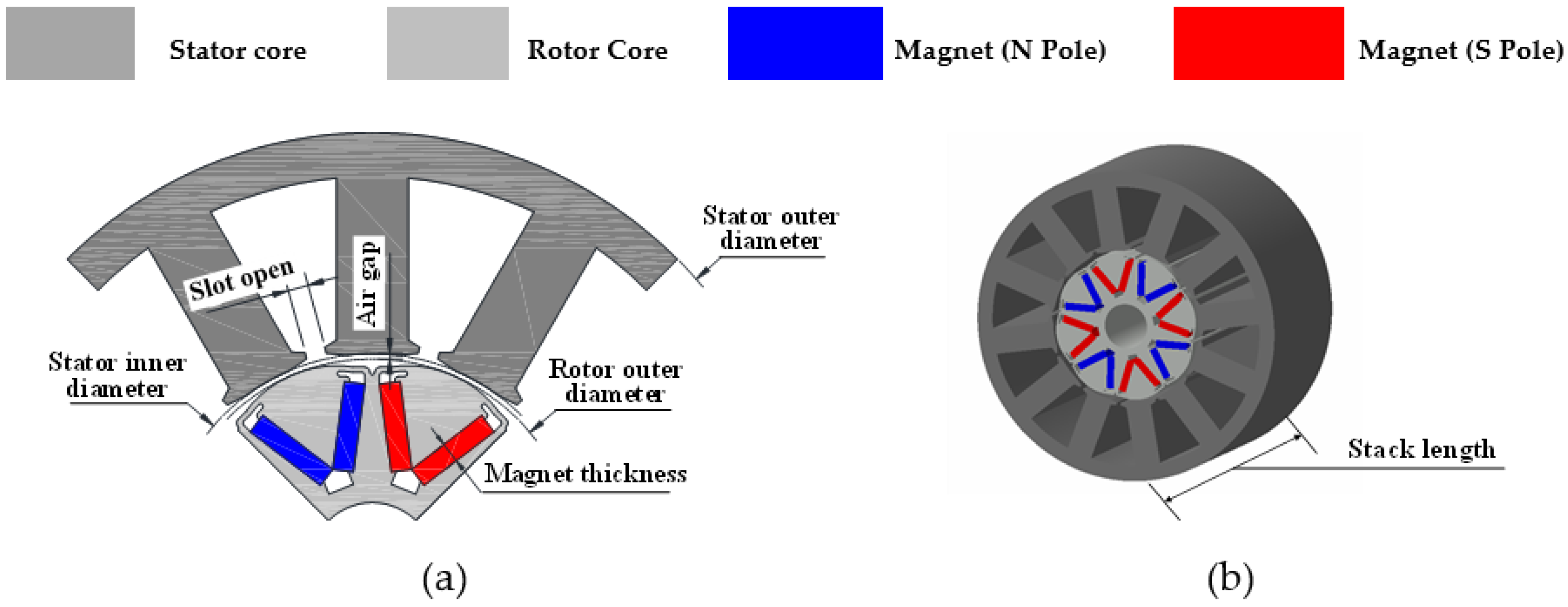

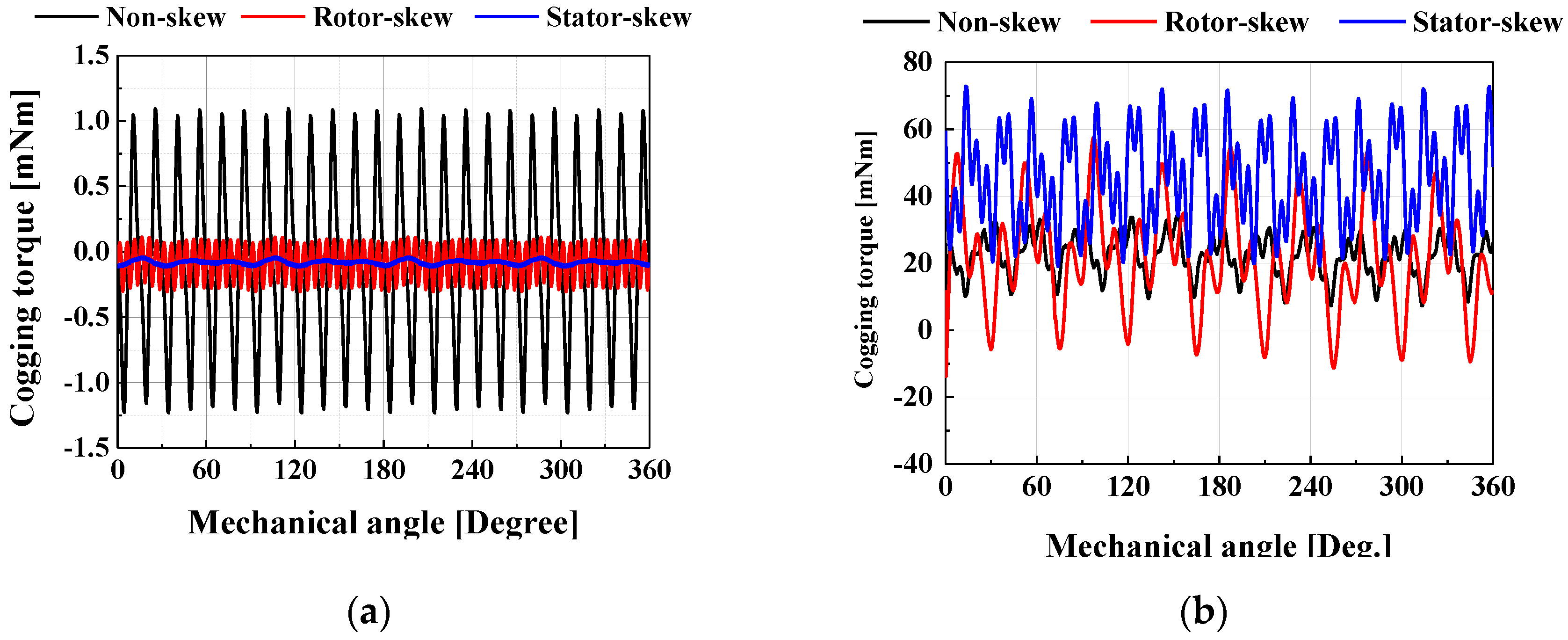
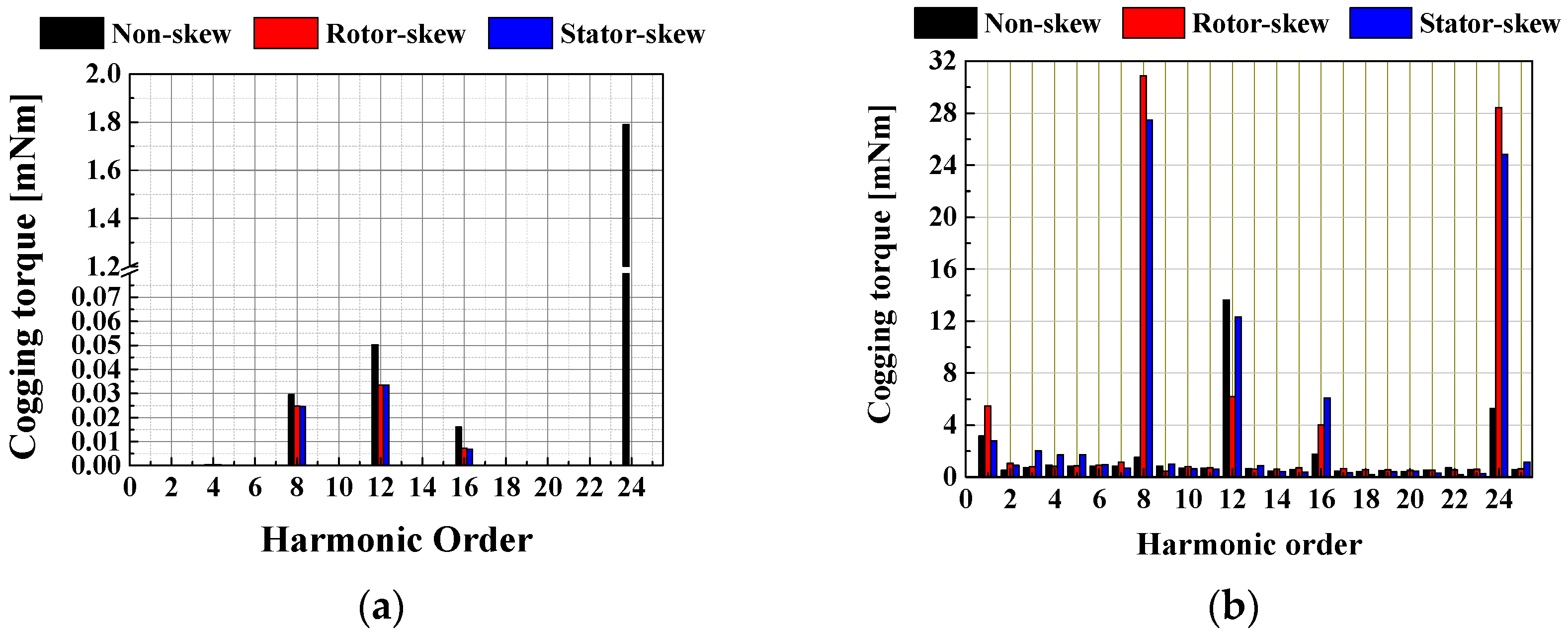
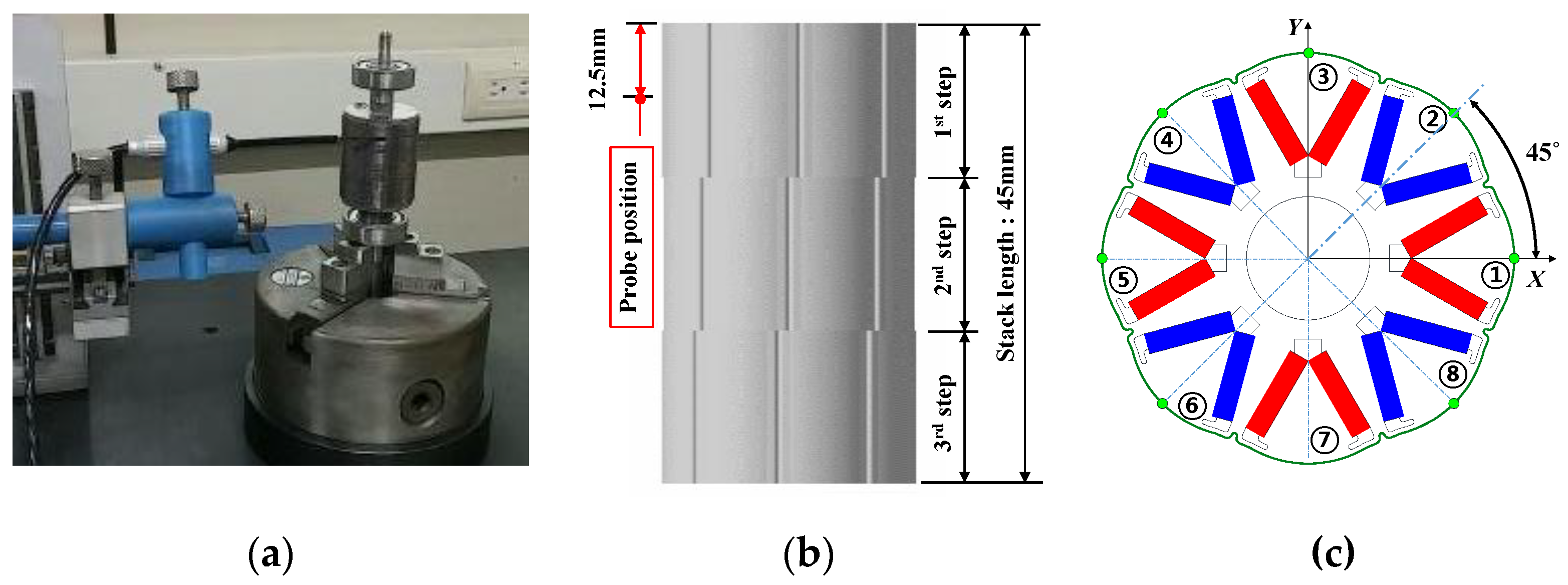
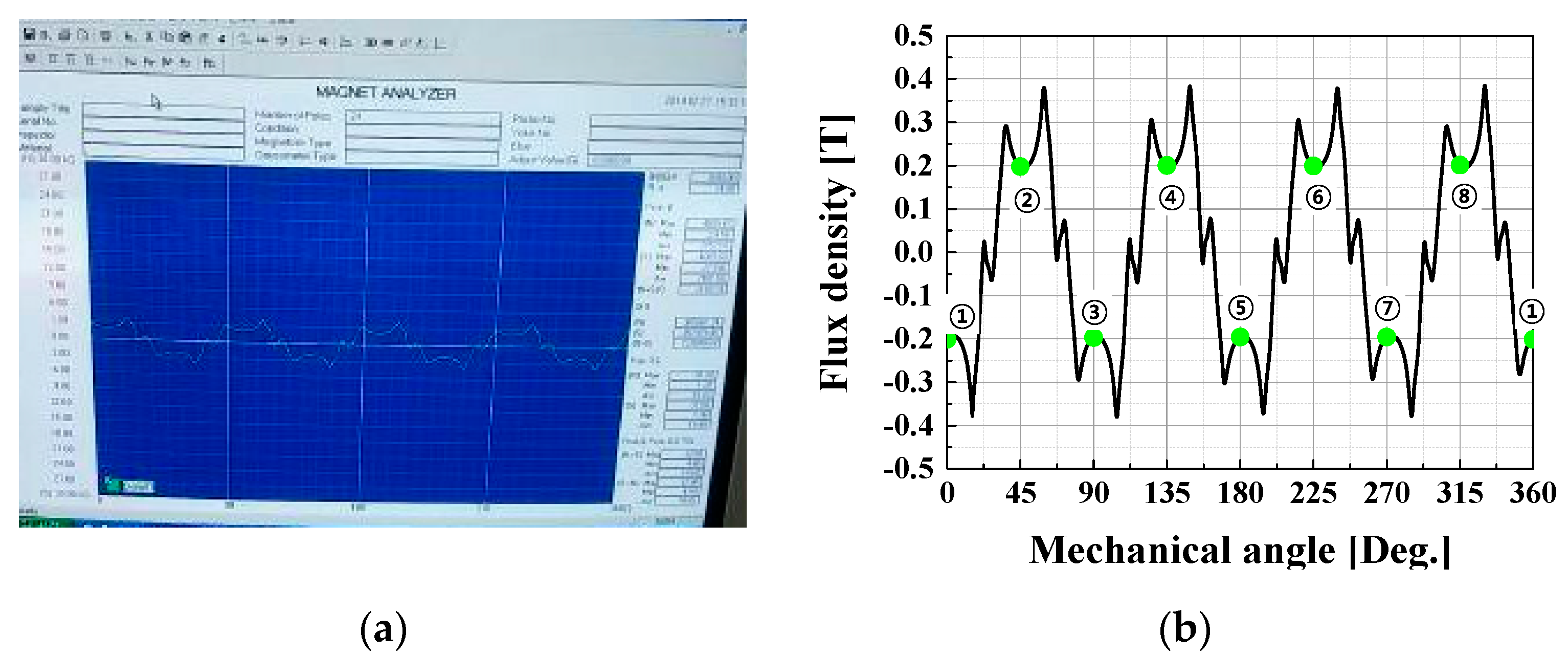

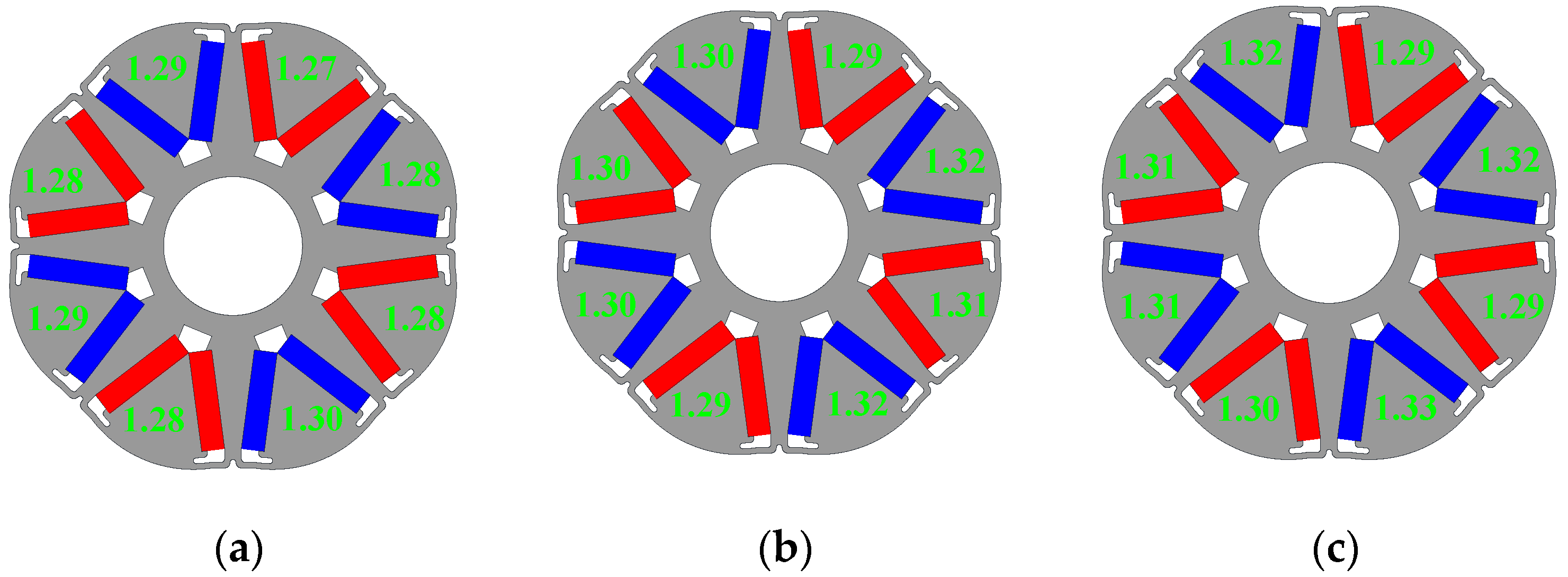
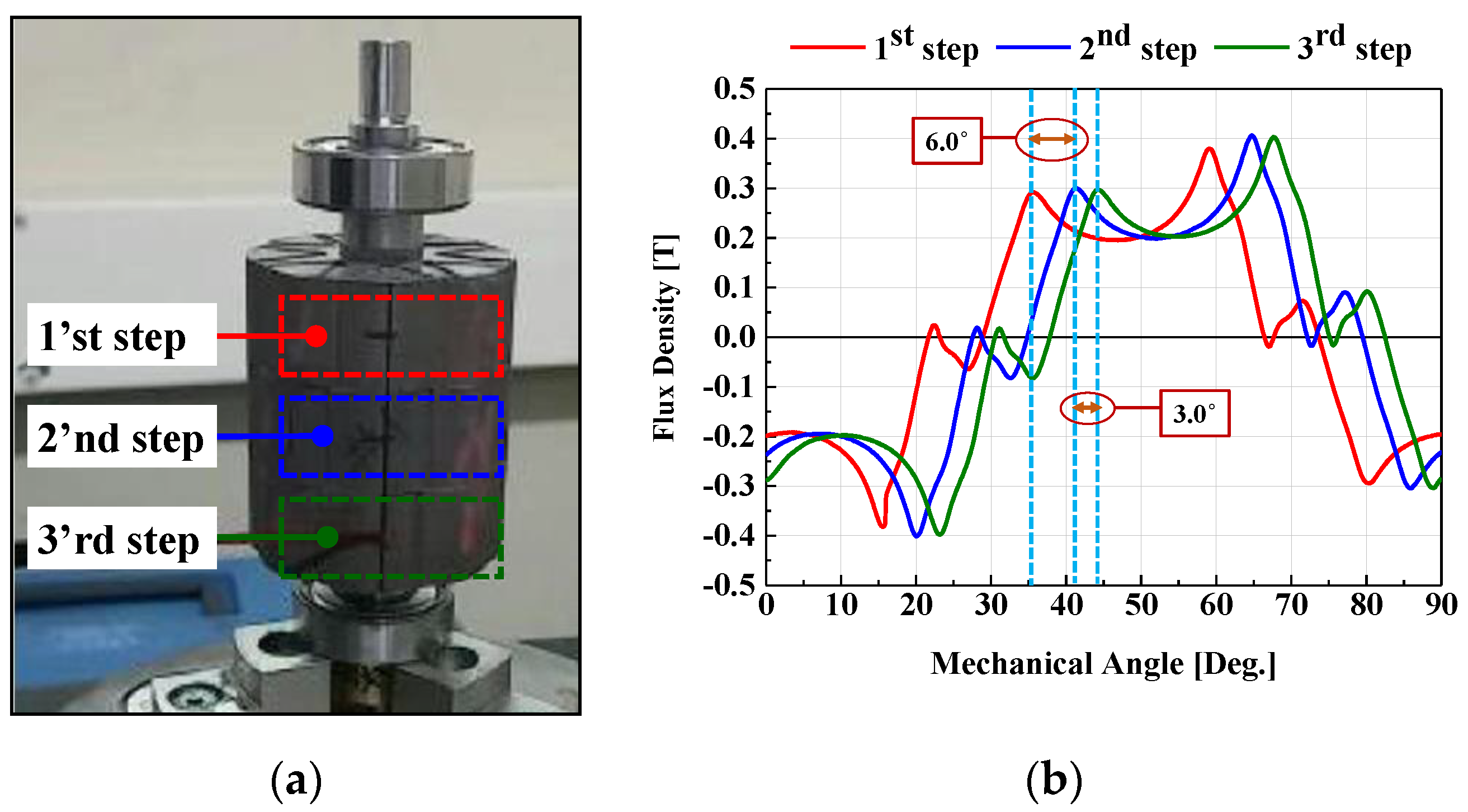
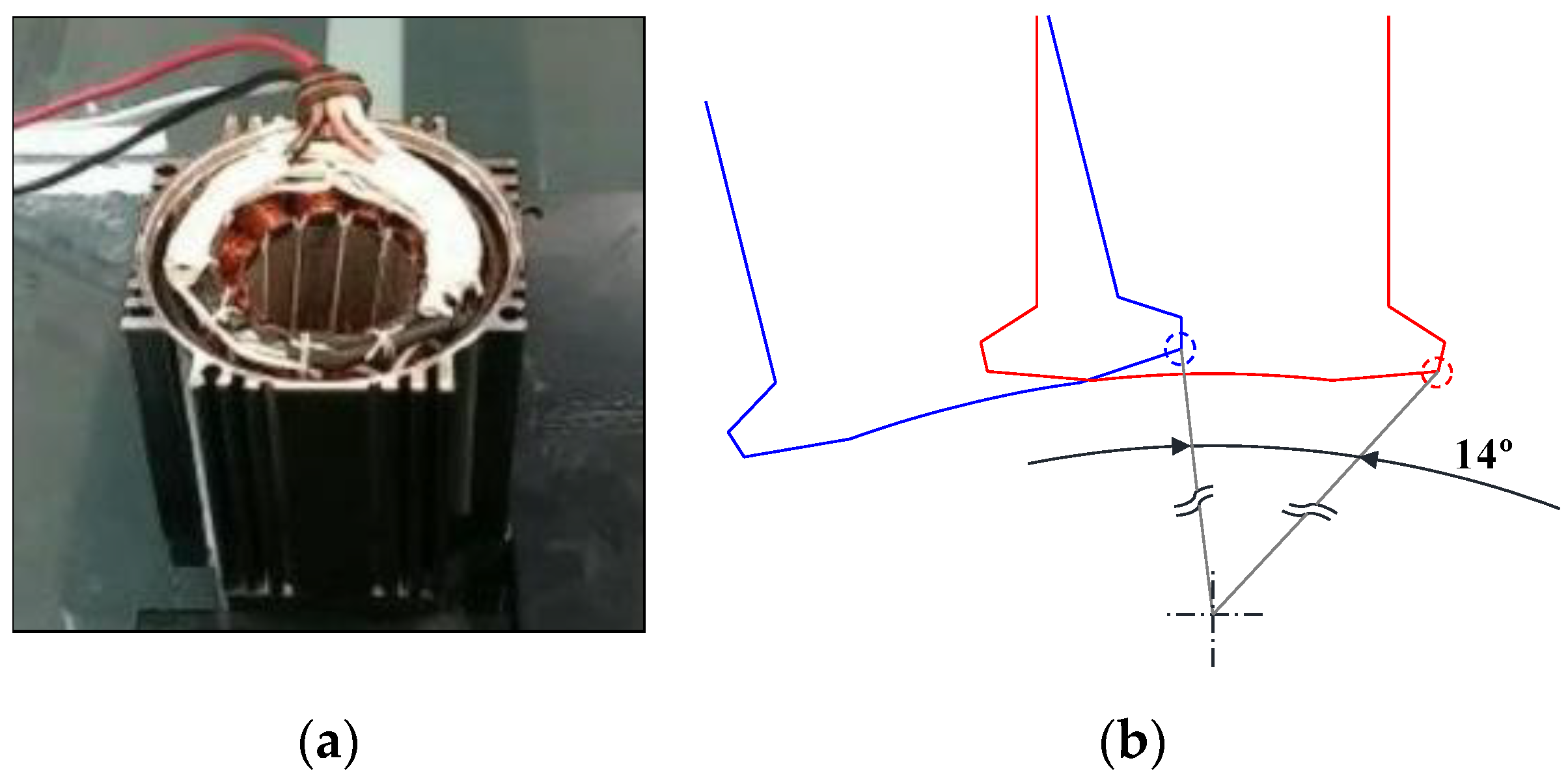
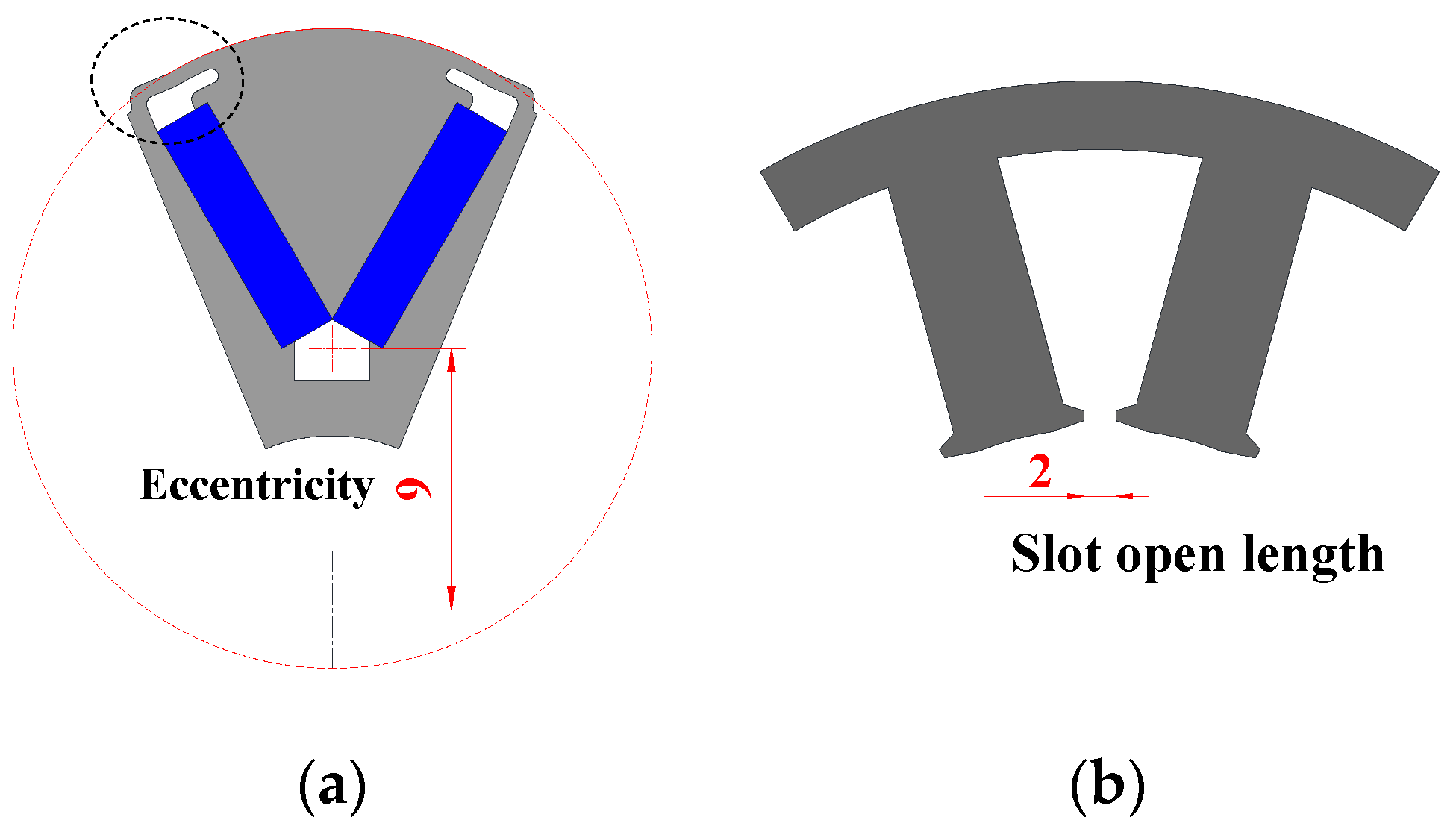

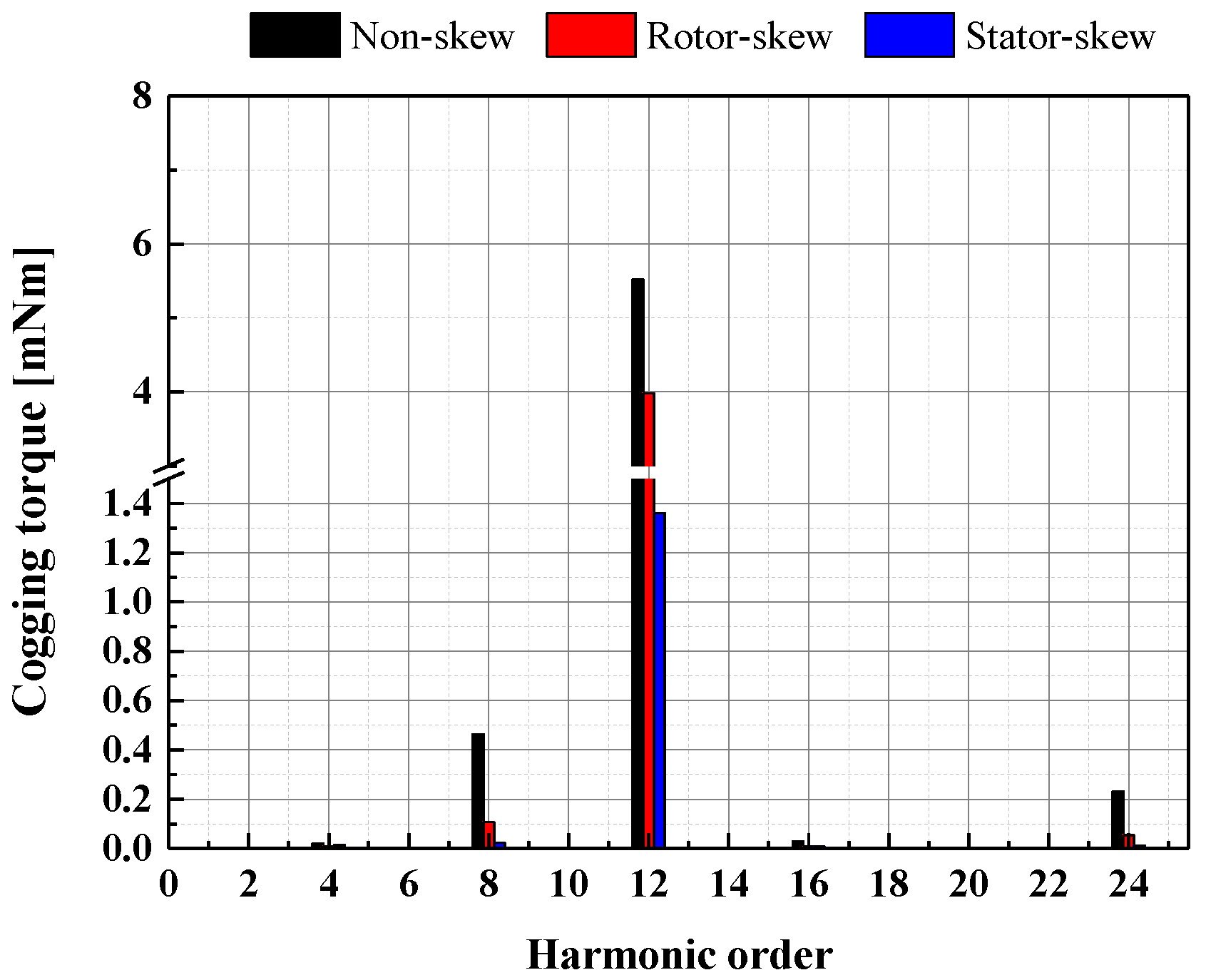

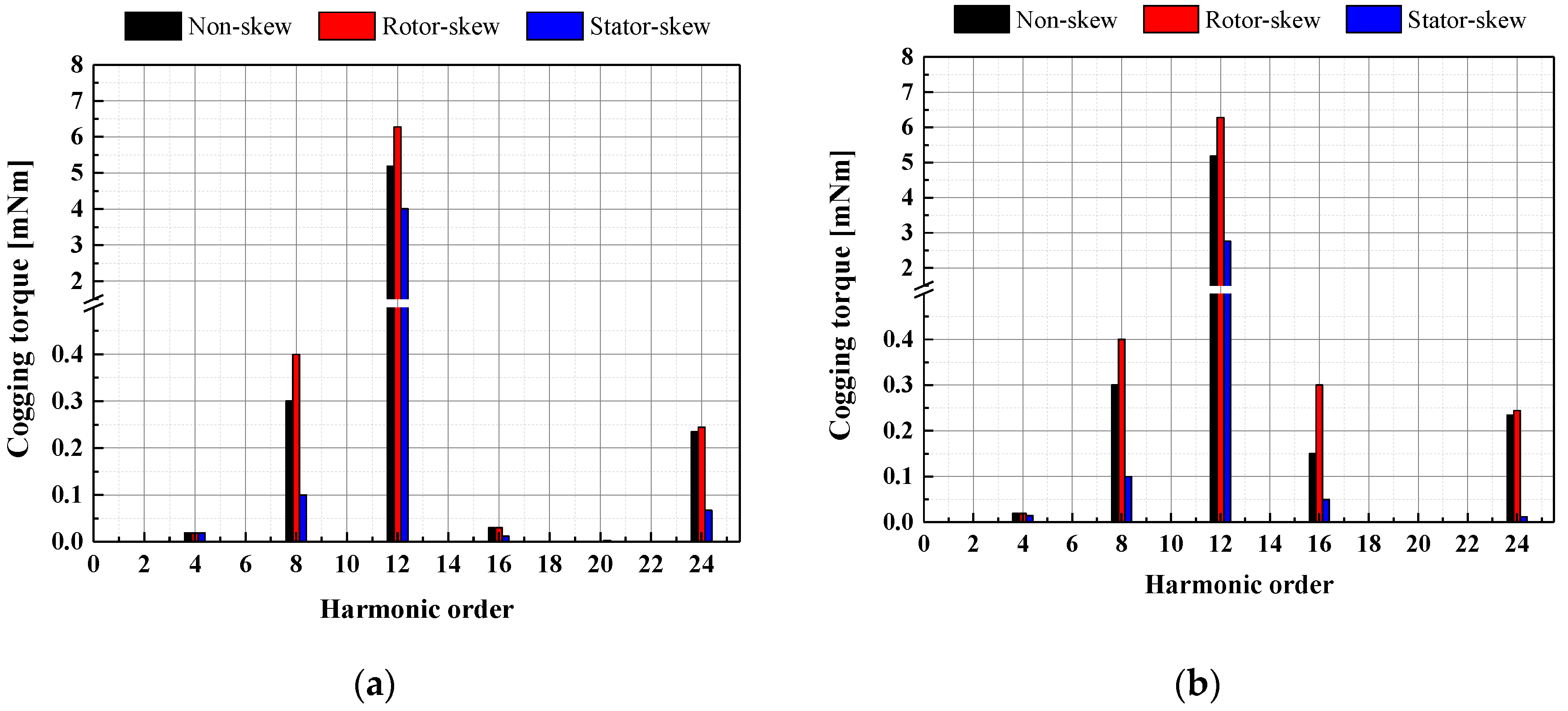
| Classification | Unit | Value | Classification | Unit | Value |
|---|---|---|---|---|---|
| Type | - | IPMSM | Air gap | mm | 0.5 |
| Phase/Pole/Slot | - | 3/8/12 | Rotor diameter | mm | 40 |
| Stator outer diameter | mm | 84 | Stack length | mm | 45 |
| Stator inner diameter | mm | 41 | Magnet thickness | mm | 2 |
| Slot opening | mm | 2 | Magnet Br | T | 1.3 |
| Skew | Stator | Rotor | ||
|---|---|---|---|---|
| Non-skew |  | 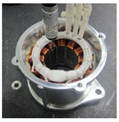 |  | 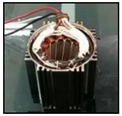 |
| 3D | Prototype | 3D | Prototype | |
| Skew |  | 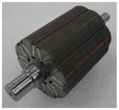 |  | 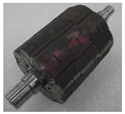 |
| 3D | Prototype | 3D | Prototype | |
| Prototype | Non-Skew | Stator-Skew | Rotor-Skew |
|---|---|---|---|
| Stator | Not applied | Nstep = 1 θskew = 15° | Not applied |
| Rotor | Not applied | Not appplied | Nstep = 3 θskew = 5° |
| Model | FEA [mNm] | Prototype [mNm] |
|---|---|---|
| Non-skew | 2.3 | 34.6 |
| Rotor-skew | 0.4 | 54.9 |
| Stator-skew | 0.1 | 71.0 |
| Classification | Causes |
|---|---|
| Dimension Tolerance | Dimension of part due to machining method and condition - Stator/rotor dimension: stamping and wire-cutting - Magnet dimension: sintering, grinding, coating, etc. |
| Assembly Tolerance | Poor tolerance management for assembling parts - Step or continuous skew angle of core lamination Assembly method: interlocking, welding, and fitting - Magnet orientation or position: bonding and fitting |
| Material Property Tolerance | Magnet: disturbances due to magnetization method - Unbalanced magnetic direction and remanent flux density Core: disturbances due to poor stamping and welding - Deterioration of B-H curve data |
Publisher’s Note: MDPI stays neutral with regard to jurisdictional claims in published maps and institutional affiliations. |
© 2022 by the authors. Licensee MDPI, Basel, Switzerland. This article is an open access article distributed under the terms and conditions of the Creative Commons Attribution (CC BY) license (https://creativecommons.org/licenses/by/4.0/).
Share and Cite
Lee, C.-S.; Kim, H.-J. Harmonic Order Analysis of Cogging Torque for Interior Permanent Magnet Synchronous Motor Considering Manufacturing Disturbances. Energies 2022, 15, 2428. https://doi.org/10.3390/en15072428
Lee C-S, Kim H-J. Harmonic Order Analysis of Cogging Torque for Interior Permanent Magnet Synchronous Motor Considering Manufacturing Disturbances. Energies. 2022; 15(7):2428. https://doi.org/10.3390/en15072428
Chicago/Turabian StyleLee, Chung-Seong, and Hae-Joong Kim. 2022. "Harmonic Order Analysis of Cogging Torque for Interior Permanent Magnet Synchronous Motor Considering Manufacturing Disturbances" Energies 15, no. 7: 2428. https://doi.org/10.3390/en15072428






